Search results for: 'Art'
-
 Uschebti aus bemaltem Ton
Uschebti aus bemaltem TonCa. 1200 - 1070 v. Chr., Neues Reich des Alten Ägypten. Vollständig intakt, nicht restauriert. Originale Bemalung weitgehend erhalten.
Price: on request Bronze statuette of Osiris
Bronze statuette of OsirisExtremely well preserved figurine with stunning fine details like the insignia and the incised neck. Late Period of ancient Egypt.
Price: on request Neolithic stone tool from Egypt
Neolithic stone tool from EgyptThe Stone Age weapon's point or knife blade is well crafted, with finely serrated edge. From a 100 year old museum collection.
Price: on request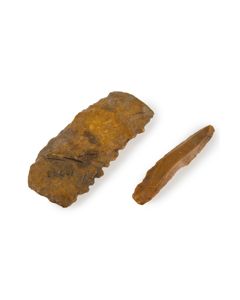 Two Neolithic stone tools from Egypt
Two Neolithic stone tools from EgyptThe Stone Age saw and the slender blade are finely worked. From a 100 year old museum collection.
Price: on request Roman glass rod
Roman glass rodThe object had a function as a distaff, a tool for spinning. Particularly noteworthy is the beautiful spiral decoration and the complete preservation of the fragile material. From the Roman Imperial period.
Price: on request Stone Age spearhead from North America
Stone Age spearhead from North AmericaFinely crafted flint projectile from the Stone Age of North America. From a swiss museum collection.
Price: on request Necklace of Egyptian mosaic glass beads
Necklace of Egyptian mosaic glass beadsModernly threaded necklace of ancient beads of spherical and cylindrical shape made of beautiful mosaic glass. From a workshop in Roman Egypt. Ex Christie's.
€5,100 Iron Age spearhead from Sweden
Iron Age spearhead from SwedenWell-preserved iron weapon, a find from the Swedish province of Värmland. Acquired in 1894 into the collection of the Bally-Prior Museum.
Price: on request Eastern Roman glass bottle with thread decoration
Eastern Roman glass bottle with thread decorationA product from the Roman province of Palaestina. The high-quality glass was created in the 6th to early 7th centuries, when the Eastern Roman Empire was thriving and the Byzantine Empire took shape.
€2,300 Paleolithic hand axe or borer
Paleolithic hand axe or borerPrehistoric stone tool. It was the universal tool of the older Stone age and could be used as a borer or chisel. From a Swiss museum collection. Found in the Algerian Sahara desert.
Price: on request Neolithic flint dagger from Denmark
Neolithic flint dagger from DenmarkDouble-edged blade and flat shaft made of beautiful flintstone. A status symbol from the transitional period between Late Neolithic and Early Bronze Age.
Price: on request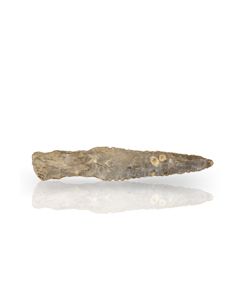 Neolithic flint dagger from Denmark
Neolithic flint dagger from DenmarkDouble-edged blade and flat shaft made of beautiful flintstone. A status symbol from the transitional period between Late Neolithic and Early Bronze Age.
€650 Disc brooch from Roman Britain
Disc brooch from Roman BritainBrooch with a Romano-Celtic sunburst design. Circa 2nd century. A find from Roman Britain
€190 Early Etruscan sanguisuga fibula
Early Etruscan sanguisuga fibulaThe early Etruscan bronze brooch is characterized by its artistically decorated bow. A find from northern Italy.
€350 Neolithic flint dagger from Denmark
Neolithic flint dagger from DenmarkDouble-edged blade and flat shaft made of beautiful flintstone. A status symbol from the transitional period between Late Neolithic and Early Bronze Age.
€480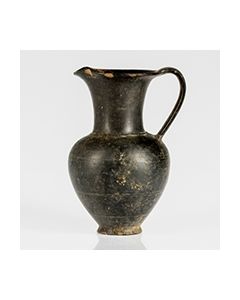 Etruscan bucchero oinochoe from Tarquinia
Etruscan bucchero oinochoe from TarquiniaLarge jar with ovoid body and trefoil mouth. Decorated with carved lines. From an old German collection, acquired in the 1950s.
Price: on request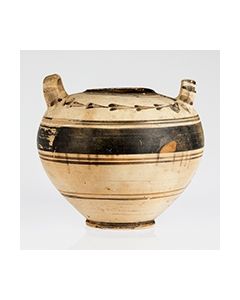 Large decorated Messapian two-handled jar
Large decorated Messapian two-handled jarPerfectly preserved, no damages or restorations. Very rare for such large vessel. From an old British collection, acquired in the 1950s.
Price: on request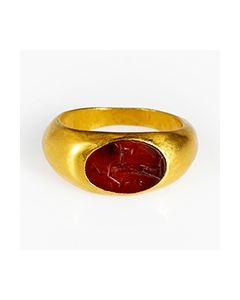 Roman ring with Mercury intaglio
Roman ring with Mercury intaglioNice gold ring with hollow band. The inserted carnelian intaglio shows Mercury, the Roman god of trade.
Price: on request Etruscan kylix found at Tarquinia
Etruscan kylix found at TarquiniaFinely worked cup with delicate foot and two handles. From an old German collection, acquired in the 1950s. Said to have been found at Tarquinia.
Price: on request Roman terra sigillata jar
Roman terra sigillata jarRoman Empire, 1st - 3rd century AD, excellently preserved. From and old German collection, acquired in the 1960s - 1970s.
Price: on request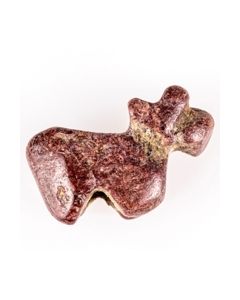 Sumerian miniature ram amulet
Sumerian miniature ram amuletNice small stone amulet in the stylized shape of a ram. From the 3rd Millenium BC.
Price: on request Large Roman balsamarium
Large Roman balsamariumStunning glass vessel with pear shaped body. Made in the Western part of the Roman empire or in Northern Italy.
Price: on request Sumerian miniature ram amulet
Sumerian miniature ram amuletNice small stone amulet in the stylized shape of a ram. From the 3rd Millenium BC.
Price: on request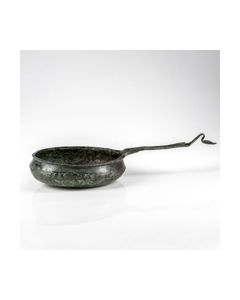 Very rare Roman bronze patera with duck head handle
Very rare Roman bronze patera with duck head handleBronze paterae with preserved handle are very rare, especially in this condition. Beautiful patina.
Price: on request Massive bronze figurine of a bull
Massive bronze figurine of a bullPerfectly preserved, undamaged, with brown-green patina. Acquired 1978 at Davies Antiques Gallery, London.
Price: on request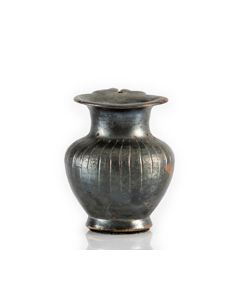 Small black glaze Oinochoe
Small black glaze OinochoeMagna Graecia, Greek colony in Southern Italy. Very well preserved, glossy metallic glaze. From an old German collection, acquired in the 1960s.
Price: on request Early Etruscan Bucchero cup
Early Etruscan Bucchero cupInteresting bucchero cup imitating bronze a vessel. Nicely preserved. From an old German collection, acquired in the 1960s.
Price: on request Einhenkliger Keramikkrug aus dem Nahen Osten
Einhenkliger Keramikkrug aus dem Nahen OstenDer Körper in Form eines Granatapfels, unten zu einem Standfuß abgeflacht. Hellorangefarbene Keramik. Fund von der Levante.
Price: on request Großer Krug mit Bemalung
Großer Krug mit BemalungFrühe bis mittlere Bronzezeit, 3. bis 2. Jt. v. Chr. Dickwandiges Tongefäß aus Jordanien mit schwarzer Bemalung und seitlichem Henkel. Höhe 225 mm.
Price: on request Museale Miniaturöllampe der Indus-Kultur
Museale Miniaturöllampe der Indus-KulturFlache runde Miniaturöllampe. Mit breiter Standfläche. Runde Grundform, darin Nase eingedrückt. Museale Erhaltung mit schöner Sandpatina und Rußspuren.
Price: on request Nahöstlicher Keramikkrug
Nahöstlicher KeramikkrugGroßer Krug aus hell beigefarbener Keramik, fast 20cm hoch. 1500 bis 500 v. Chr., Späte Bronzezeit bis Eisenzeit.
Price: on request Sichel aus der Bronzezeit
Sichel aus der BronzezeitBronzezeitliche Knopfsichel mit fließend geformtem Sichelrund und einer flach-konkaven Klinge. 2. Hälfte des 2. Jt. v. Chr., Europa. 85mm lang.
Price: on request Amphoriskos aus der frühen Bronzezeit
Amphoriskos aus der frühen BronzezeitKugelförmiges Tongefäß mit gekerbtem Dekor aus Jordanien. Rußspuren an der Unterseite weisen auf die mögliche Verwendung als Kochgeschirr hin. 3100 v. Chr. bis 2200 v. Chr.
Price: on request Öllampe der Indus-Kultur - selten
Öllampe der Indus-Kultur - seltenFlache tropfenförmige Öllampe mit breiter Standfläche. Auf einer Drehscheibe gefertigt, dann von Hand in endgültige Form gebracht.
Price: on request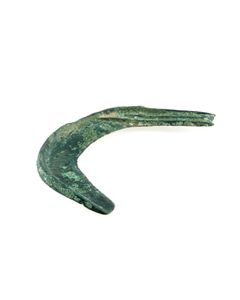 Sichel aus der Bronzezeit
Sichel aus der BronzezeitBronzezeitliche Knopfsichel mit fließend geformtem Sichelrund und einer flach-konkaven Klinge. 2. Hälfte des 2. Jt. v. Chr., Europa. 100mm lang.
Price: on request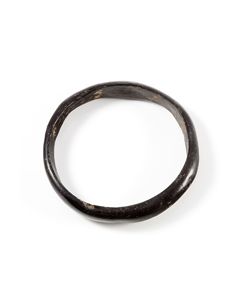 Römischer Glasarmreif
Römischer GlasarmreifAntiker Armreif aus schwarzem bis dunkelblauem Glas, mit Irideszenz. 1. bis 4. Jh. n. Chr., römische Zeit. In Schleudertechnik gefertigt. 60mm Durchmesser.
Price: on request

